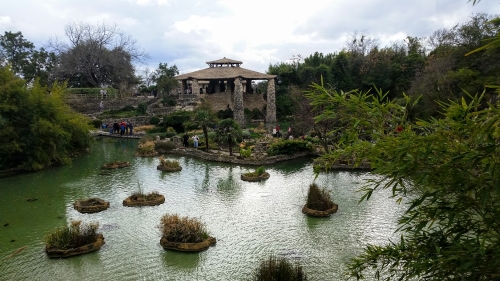As I’ve mentioned before, the site that’s now Brackenridge Park used to be the headquarters for the Alamo Cement Company. The limestone was quarried on-site and when the “carpetbagger” George Washington Brackenridge donated land to the city and the widow of the founder of the Pearl Beer company, Emma Koehler, followed suit by donating some adjoining land, the city ended up with a decent number of old quarries to do something with.

The city parks commissioner at the time, Ray Lambert, decided to turn this particular quarry, which was right behind the cement company, into a lily pond. The lily pond project got bigger and bigger until it became a full garden with ponds and the city invited Kimi Eizo Jingu, a Japanese-American artist, to move into one of the buildings with his family, where they ran a restaurant. The Jingu family was disinvited to live there in 1942, while we were at war with Japan (and, indeed. had confined a large number of Japanese-Americans in internment camps).
At this point, they changed the name of the garden to the Chinese Sunken Garden, and moved a Chinese family, the Wus, into the house. The Wus lived in that house for around 20 years.
Eventually the city got over World War II. They changed the name back to the Japanese Tea Garden in 1984.
I moved to San Antonio in 1993 and the garden had fallen into disrepair by then. Thomas and I hiked out there on a whim when we were in Brackenridge Park to visit the zoo. Someone else was with us. It was a long time ago and I cannot remember if it was our friend Frank or my parents. Maybe it was one of Thomas’s parents. Well, my dad says it wasn’t them, so that leaves Frank or Thomas’s folks.
Anyway, when we got out there we were underwhelmed. I don’t even remember if there was water in the ponds, it was so bad.
Then, in 2007, they began a major renovation project. They rededicated the gardens in 2008 and it’s well worth the stop now. There are koi ponds and walking paths, and a really lovely artificial waterfall. There are also signs warning visitors not to release fish into the ponds and Alex and I joked about putting kraken and such into it.
The building that the Jingu family lived in is now a restaurant (and I’m ashamed to admit that I’ve never eaten there — the one time I tried, it was January and they had some kind of weird abbreviated winter hours).
The Japanese Tea Garden is not what you’d call handicap-accessible. The paths are narrow and there are steps everywhere. One can sit in the covered pagoda area and see pretty much everything. My understanding is that the Jingu House is handicap-accessible.
Gratuitous Amazon Link time. This actually looks like something I might want to buy. Since the Japanese Tea Garden is so tied up in San Antonio’s history, I looked for San Antonio history books and found San Antonio: Our Story of 150 Years in the Alamo City, by the Staff of the San Antonio Express-News.
